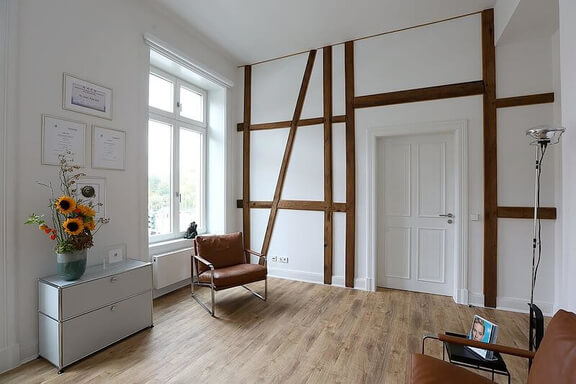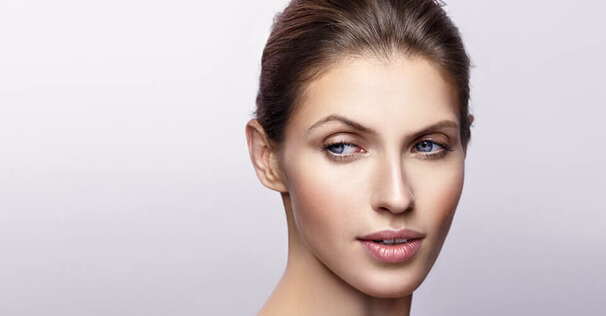Facts on Eyelid Correction
| Duration: | appx. 1 hour |
|---|---|
| Anesthetization: | local anaesthesia (can be combined with sedation) |
| Treatment: | ambulant |
| Strapping: | skin-coloured slim tape |
| Stitch removal: | after 1 week |
| Down time: | 1-2 weeks |
Eyes are the windows to the soul
People with beautiful eyes are normally considered beautiful. The livelier and more alert a person’s eyes are, the more vital and open-minded the person seems.
Our eyes are the two most important points on our faces. They give us our charisma, which means vitality and attractiveness. Our eyes determine how we see the world... and how the world sees us as well.
The eyes are the windows to the soul - how wonderful when someone (else) can light them up!
EYELID CORRECTION – MINOR PROCEDURE, MAJOR EFFECTS
The appearance of our eyes changes over time. Life circumstances, stress, and environmental influences all affect our facial skin. And our genetics play a significant role in the slackening of our connective tissue. The sensitive skin around our eyes is one of the areas most affected by these influences.
If our eyelids are not harmoniously shaped, it has a major influence on our appearance—and on how other people judge us. People often use our eyes to judge our physical or mental health; drooping upper eyelids and bags underneath our lower lids make us look tired and worn out, even if we aren’t.
Low eyebrows and dark circles under the eyes make our eyes look small and dark, which gives us a tired, sickly look and makes our faces seem generally older and less friendly.
And because our eyes are so important to our personalities, eyelid corrections can provide wonderful improvements. That also applies to targeted, ultra-fine wrinkle filler injection treatments, provided that they are done well. A minor procedure that may have big effects.
SAGGING EYELIDS, BAGS UNDER THE EYES, TIRED-LOOKING EYES – WHAT CAN BE DONE ABOUT THEM?
Hanging upper eyelids make eyes appear smaller and more tired. The excess skin covers the natural eyelid fold and makes putting on makeup more difficult... and smeared eye shadow or liner is certainly annoying! In severe cases, where the eyelid compromises the patient’s field of view, there may even be a medical indication for upper eyelid correction.
Under-eye bags (swelling underneath the eyes) or dark circles often make people look overworked or poorly rested. These bags are made up of the fatty tissue within the eye sockets, which bulges outward and thus pushes the lower lid forward. This fatty tissue near the lower lid is divided up among three chambers, each of which may bulge outward to a greater or lesser degree. Which is why under-eye pouches may have different shapes or characteristics.
If drooping eyelids or under-eye swelling are a concern for you, you may want to consider eyelid tightening (blepharoplasty). Depending on your particular situation, this may involve tightening the upper lid, the lower lid, or both in a single operation.
Non-surgical procedures may be an option for you as well. For example, eyelid skin structure, eye wrinkles, dark circles, and tear troughs can also respond well to Botox®, superfine hyaluronic acid or fat transfer injection therapies, and special laser treatments or peelings.
UPPER EYELID TIGHTENING - TECHNIQUE
Before performing the operation on your upper eyelids, we measure the exact quantities of surplus skin and muscle around each eyelid as part of our surgery planning. We also draw these on in order to give ourselves precise orientation during the operation, which is important in order to ensure that we do not remove too much tissue. It also helps us position the incision very precisely within the eyelid fold, which is key to ensuring that the subsequent scar is fine and inconspicuous.
In upper eyelid correction surgery, we tighten (lift) the upper lids by removing excess eyelid skin. This may also involve removing excess fatty tissue, although it is important not to remove too much fat, because it can give you a hollow-eyed look. That is why we always localize and measure areas of fat protrusion precisely and then remove only what is necessary for treatment purposes.
We also look for excess tissue deposits extending above and to either side of the eyelid region, so that we can treat them if necessary, for example by doing what we call a lateral extension.
Upper eyelid tightening (lifting) works generally very well using local anesthetics, either alone or in combination with twilight anesthesia. Of course, we can also perform the operation (here at our practice in Hamburg) using general anesthesia if you prefer.
LOWER EYELID TIGHTENING - TECHNIQUE
In corrective lower lid surgery, we lift the skin and musculature of the lower eyelid to achieve a tightening/lifting effect. We can also remove any under-eye pouches at the same time. Depending on your particular situation, we will either remove or redistribute the excess fatty tissue in the under-eye pouches.
In lower lid corrections, we use either a “subciliar” approach from the outside, or a “transconjunctival” approach from the inside of the eyelid. When approaching from the outside, we make the incision just underneath the eyelashes; internal access incisions are made on the back of the lid near the conjunctiva, and are thus not visible.
We pay close attention to each individual patient’s eyelid tension, which can be (and should be, if necessary) supported or augmented as part of the lower lid correction and tightening process. We have a variety of surgical methods at our disposal to achieve this (including so called lower eyelid suspension/canthopexy, lateral tarsal strips, etc.).
Lower eyelid tightening (lifting) works generally very well using local anesthetics, either alone or in combination with twilight anesthesia. Of course, we can also perform the operation (here at our practice in Hamburg) using general anesthesia if you prefer.
EYEBROWS AND CHEEKS – IMPORTANT NOTES BEFORE THE OPERATION
The question of which treatment methods would be most feasible and effective for an individual patient is not just about the eyes themselves. It also concerns the area around them, i.e., the eyebrows and the cheeks. This is why, here at our practice in Hamburg, we place great importance on considering the eye area as a whole.
Because not everything that LOOKS like a drooping eyelid really IS a drooping eyelid. Oftentimes, low or sunken eyebrows are actually giving the upper lid a “droopy” appearance. In such situations, an eyebrow lift may make much more sense than eyelid tightening alone.
Similarly, under-eye pouches are not always exclusively a problem of the lower eyelid; in many cases, shrinking cheek volume or sagging cheeks are involved as well. For this reason, certain patients may benefit from targeted volume-enhancement treatments around their cheeks or cheekbones. Surgical cheek lifting, in the form of a face lift or mid-face lift, may be another option.
Thus it would be a mistake to focus isolated attention on the eyes alone, which is why, before undergoing corrective eyelid surgery, you should seek the advice of a specialist who has a wealth of experience with not only eyelid corrections, but with the surrounding areas as well.
TREATMENT PROCESS
Proper medical treatment requires solid knowledge and extensive experience. Optimum treatment processes also require sufficient time.
And we take that time for you. Our practice in Hamburg always schedules generous amounts of time in for each treatment, so that we can ensure that we are not under time pressure with any of our patients.
Should you decide to undergo surgery/treatment, we will go over the essentials with you again during the second consultation (also called the surgery planning meeting). Our surgical and anesthesia teams will help you prepare for surgery in order to ensure your safety.
After treatment, our experienced surgical team or night team will personally take care of you. You will receive important information and patient guides on post-surgical care, and we will work with you directly to set up additional examination or treatment appointments
EYELID CORRECTION SURGERY BY A SPECIALIST
Thanks to his specialization in facial surgery, Dr. Arlt has many years of experience with eyelid corrections.
At your initial consultation meeting here in our Hamburg practice, we will start by analyzing your diagnostic findings precisely and explaining the options that make most sense in your case. After that, you can discuss the right treatment methods for you with Dr. Arlt, and then go home to weigh the alternatives at your leisure. You are welcome to bring your partner to your second in-person appointment with Dr. Arlt, at which we will discuss the options explained before in greater detail and address any questions you may have.
Contact
Dr. Axel Arlt
Practice community
Esplanade 31 / Ecke Stephansplatz
D - 20354 Hamburg
Phone: +49 (0)40 - 413 55 66 9
Mail: info@dr-axel-arlt.de


